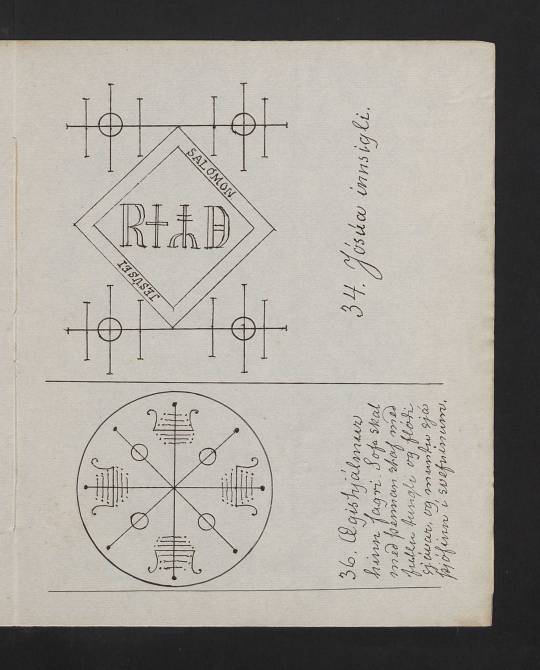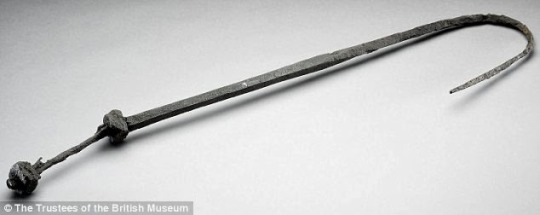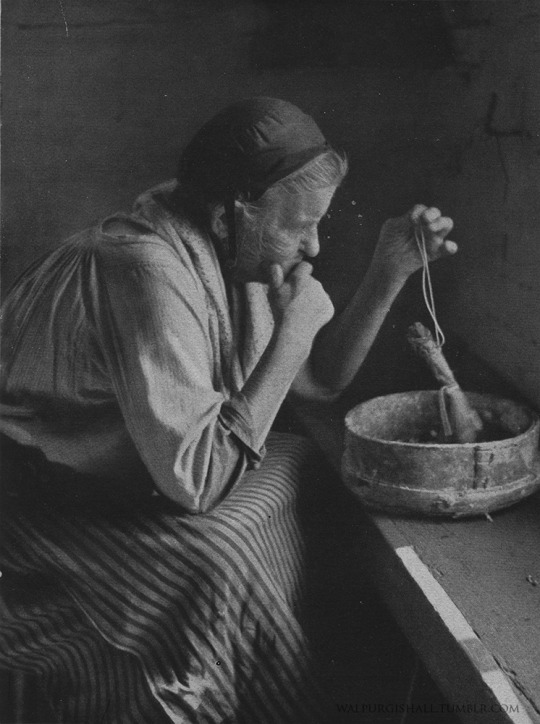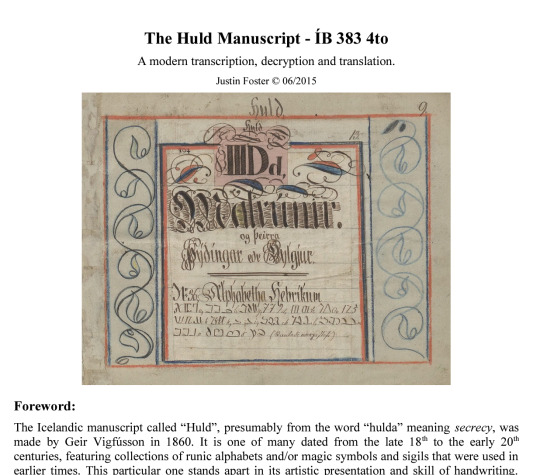Note
I was sent here by Fjörn to seek some insight into "Odin's illusionary rune" as he said you have greater knowledge of such things. I'm basically seeking more information on its purpose as well as its origins, because I can't find a lot online. Any light you could shed on the matter would be greatly appreciated. Thanks!

“Missinningastafur Oðinn eingin forskrift”:
mis-sýning, f. deception of sight.
enginn, qs. einn-gi from einn, one, and the negative suffix -gi :– none.
for·skrift f. formula.
In other words, just as Odin deceived many people with his disguises, you can get the same results using this magical stave.
This stave is repeated in several copied manuscripts and generally appears in the same form (the one above has been copied from the 1670s). One exception, from 1934, has a formula and a description of the results - to put your enemy into darkness and turn him in circles, and under other circumstances drive him crazy. Nasty stuff - I would not recommend using this!
The “no formula/specifications” stated in the other manuscripts may be due to the malicious nature of the spell, i.e. getting caught with something like this would not get much mercy from judicial prosecutors.
98 notes
·
View notes
Photo

Today on my Instagram I’m writing about this magical beauty, St. John’s Wort. This plant can be found in the wild, and is known to help against anxiety and depression. I find the mere scent soothing for the soul. According to folklore, St. John’s Wort, or Johannesört in Swedish, also has protective powers, especially around midsummer’s.
35 notes
·
View notes
Text

Icelandic magical symbol, Stafur til að vekja upp draug, To invoke ghosts and evil spirits.
https://www.etsy.com/se-en/listing/636930148/stafur-til-a-vekja-upp-draug-icelandic
691 notes
·
View notes
Photo

Waxing Horn belonging to a witch, Budal, Sør-Trøndelag
44 notes
·
View notes
Text

heathenfairytale said:
Isnt Ægishjálmur mentioned in Volsunga sag?
Yeah, Ægishjálmur is mentioned in Fáfnismál, one of the poems in the Poetic Edda which was worked into Völsunga saga, and the description of it – that it strikes fear into your enemies – is also present, but the symbol itself doesn’t actually appear in any of those manuscripts as far as I know. It seems to be a physical object rather than a repeatable symbol:
Sigurður fann þar stórmikið gull og sverðið Hrotta, og þar tók hann ægishjálm og gullbrynjuna og marga dýrgripi.
‘Sigurður found there a great deal of gold and the sword Hrotti, and took from there the ægishjálmur and gold-armor and many precious treasures.’
[Edit: I changed my mind about how valuable this piece of evidence is: http://thorraborinn.tumblr.com/post/93430829603/thorraborinn-hedendom-heathenfairytale]
One of the difficulties in tracing the origin of late Icelandic things is that they never stopped reading old Icelandic things, and trying to interpret and adapt them into their contemporary context.
Ægishjálmur does occupy a unique position among the other staves though, not only because the name is mentioned early on, but also (in my opinion; I haven’t seen this written anywhere by any specialists) because of the relative simplicity of the symbol which makes it look like something of a template for later ones.
There is also an Indian symbol which is startlingly similar which some people have suggested points to a common origin although I would say it’s a simple enough symbol that two independent inventions (especially that aren't exactly the same) doesn’t sound unrealistic. I am aware of at least one cross-shaped bindrune from an early inscription though I can’t find it or remember what it says… it’s a five-letter word with one letter on each “spoke” and one in the middle at the intersection. So it could be an example of the idea in development.
By my own estimation, it seems most likely that the symbol came into use, and then eventually someone noticed it was being used in a manner similar enough to what is described in Fáfnismál/Völsunga saga that they came to be identified with each oher.
There actually are a few symbols called Ægishjálmur beside the well-known one:

“Nine Ægishjálmar” from Galdrasýning, not sure from what manuscript.

“Ægishjálmur the beautiful” from Jónas Jónasson’s notes, attributed to Sigurður Jónsson (the bottom one).
27 notes
·
View notes
Photo

Viking Magic Wand
For decades the experts at the British Museum believed that this item, discovered at a woman’s grave from Norway was just a hook used in fishing. However, new research suggests that it was her ‘magic wand’ and that it was deliberately bent to destroy its power.
The Times newspaper reported that this item, a 90 cm long iron rod, was first brought to the British Museum in 1894. British Museum curator Sue Branning believes that it was probably a magical staff used to perform ‘seithr’, a form of Viking sorcery predominantly practiced by women.
She told The Times: ”These are magical practices, which we don’t fully understand. It involves divination, prophecy, communication with the dead and making people do things. Our rod fits, in terms of its form, with a number of these rods that turn up in the 9th and 10th century in female burials. They normally take the form of these long iron rods with knobs attached to them.”
The rod would have been ‘ritually’ destroyed in order to prevent the sorceress from rising from the dead, or to stop anyone else from using it. Branning adds, ”When we hear about the Vikings we hear all about the powerful warriors, but now we know there were also powerful women. These women were very well respected, but they were quite feared as well. They may have been on the margins of society. You might not want to get close to them because they have this power. The sources we have describe them as wearing blue and black cloaks with gems attached.”
Source
7K notes
·
View notes
Text
Today is Skärtorsdag (Maundy Thursday) here in Sweden. This is the day when the witches flies to Blåkulla to visit the Devil. I thought I’d share some interesting witch facts with you all, to honour this witchy day.
Archeological finds here in the Nordic countries shows that witchcraft has been used during the prehistoric age/yore. Witchcraft for good hunt and for good harvest are suggested to be found on rock carvings.
The Sami have a wizard (nåjd) that will drum himself into trance with the zoetrope.
The word ‘häxa’ that means ‘witch’ wasn’t used until the later half of the 1600’s. Before that people called them ‘trollpacka’, ‘trollgubbe’ or ‘trollkärring’. Also the term ‘trollkunnig’ was common. Trollkunnig means ‘magic knowing’.
In the law the witchcraft paragraph was revoked 1779 by the enlightenment king Gustav III. It was met with great opposition from the priests.
The church claimed that the ‘magic knowing’ got their power from the Devil. This led to witch hunts in the 1600’s. During the 60’s and 70’s around 250-300 people were executed for witchcraft.
About the hunts in Bohuslän a narrator of our days tells that “When the witches got too difficult the county man would come and arrest a flock of suspects. Some were laid on the stretch bench, but they felt nothing, because the sufferings were transfered to some animal nearby. Others were thrown into the water. They who floated were guilty. They hid needles in their pockets to make themselves sink, but the trick was discovered and the guilty ones were burned. As far as the smoke reached nothing grew for seven years.”
Witches were not all seen as evil, they were known as wise people as well. They knew things about the unknown and they could do good as well as evil. Many witches were healers and they could help people with their injuries as well as their crops and love life.
Sources for these withcy facts are Ebbe Schön’s two books ‘Svenska sägner’ and ‘Häxkonster och kärleksknep’. c:
359 notes
·
View notes
Text
Icelandic books of magic
Here a list of Icelandic books of magic that can be found online:
Einkaeign manuscript
Huld manuscript
Galdrastafir
Rúna- og galdrkver
182 notes
·
View notes
Quote
I give you blood,
Satan gives you power.
You shall run for me on earth,
I shall burn for you in hell.
You shall travel through forests and fields,
gathering milk and cream.
A story collected in Norway, 1929, has a witch, named Lispet Snipånn, who had her farmhand collect all the wood shavings; on Thursday night she would roll them into a ball and put three drops of blood (from her finger) on it. The incantation “Now I have given you flesh and blood. May Old Nick give you power and life” turned the ball into a troll cat. Another spell was recorded in Sweden, 1908, which is quoted above.
(via ioqayin)
141 notes
·
View notes
Photo




Miron-Aku was one of the last infamous finnish witches, the keeper of the ancient knowledge. Her rituals were recorded for studies during the Ahnenerbe expedition, which was led by Yrjö von Grönhagen by the personal appoinment from Henrich Himmler.
2. For Miron Aku, her house not only is her dwelling place, but also the home of the souls of her ancestors, whom she is greeting in the picture.
3. The neighbour thinks she can predict the future by using the pendulum.
4. Miron-Aku reenacts the ritual of transmission of the powers of a tietäjä to an apprentice
2K notes
·
View notes
Note
Hello lovely, just dropping in to say I adore your blog. I've been looking for a blog that focuses on Scandinavia and Iceland for a while now and yours is exactly what I was hoping to find!
Thank you! :)
0 notes
Photo

Just bought this book, I really hope its good. If it is, I will probably make some posts from it later on.
9 notes
·
View notes
Note
How is Draumstafir used and what does it mean?
Draumstafir is an icelandic magical staff and simply put it is a magical symbol used to dream of unfulfilled desires.
They way it is used is explained in the Huld Manuscript by Geir Vigfússon from 1860:
“Scratch these symbols on silver or white leather, on St. John’s Night and they who sleep on them dream about what they want when the sun is at its lowest.”
(St. John’s Day is known as Midsummer: the Nothern European solstice between 21st and 25th of June. However St. John’s Night may refer more spesifically to St. John’s Eve: the night before the 24th og June.)

Source
Original page from the Huld Manucript
155 notes
·
View notes
Photo

English translation of The Huld Manuscript by justins-galdrastafir - Justin Foster
The Huld Manuscript on academia.edu (Translated version)
The original Huld Manuscript
Explanation of galdrastafir on Justin’s homepage
Justin’s academia.edu page
53 notes
·
View notes
Photo

Gloson
In Swedish folktradition, Gloson is a terrible ghost pig that was a part of the challenges a year walker faced on a year walk (Sw. årsgång). She, the pig is usually a sow, could run between the legs of a person and cleave him or her in half. Sometimes she carried a scroll or a book in her mouth, and the one who snatched it could learn magic.
Artwork by fromfarbeyond and description by suttungsbrew
437 notes
·
View notes
Note
Dear Northern Witch, I have great interest in Årsgång, or the swedish year walk. I am familiar with Lasabrjotur, the staff for lock breaking, and the invocation that needs to be uttered. My question is, is there any particular way it should be written or placed on a lock? My Swedish is nonexistent, and I can hardly ask my Swedish grandmother about neo-pagan/christianic rite. Any enlightenment would be most welcome.
I’m sorry to say I know little about Årsgang, I’ve read little about it. The person I can think of that might know this is Tommy Kuusela. You can find a lot of his work here: http://su-se.academia.edu/TommyKuusela or contact him through instagram: https://instagram.com/suttungsbrew/ (he posts a lot of interesting things there). He has a paper on the Year Walk or Årsgang but you have to make a request to him (https://www.academia.edu/13477201/Year_Walk_an_Old_Swedish_Divination_Technique).
hedendom has a post about theYear Walk / Årsgang.
Hope this helps!
11 notes
·
View notes
